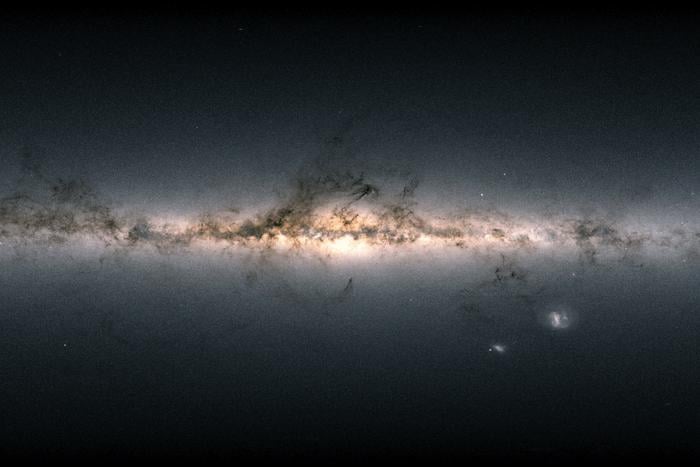Summary: A novel deep-learning algorithm developed by EPFL researchers can differentiate between the effects of self-interacting dark matter and active galactic nuclei feedback in galaxy clusters with 80% accuracy.
Estimated reading time: 6 minutes
In a significant advancement for astrophysics and cosmology, researchers at the École Polytechnique Fédérale de Lausanne (EPFL) have created an artificial intelligence algorithm capable of distinguishing the subtle effects of dark matter from other cosmic phenomena. This breakthrough, published in Nature Astronomy, could revolutionize our understanding of one of the universe’s most enigmatic components.
Dark matter, which makes up approximately 85% of all matter in the universe, has long perplexed scientists due to its invisible nature. While its gravitational effects on galaxies and cosmic structures are observable, directly studying dark matter has proven challenging. One leading theory suggests that dark matter particles might occasionally interact with each other, a phenomenon known as self-interaction. However, detecting these interactions has been difficult due to interference from other cosmic effects, particularly those caused by active galactic nuclei (AGN).
Why it matters: This new AI-based approach could significantly accelerate dark matter research by allowing scientists to analyze vast amounts of astronomical data more quickly and accurately. As new telescopes gather unprecedented volumes of information, this tool could help reveal the true nature of dark matter, potentially reshaping our understanding of the universe’s composition and evolution.
Unraveling Cosmic Complexity with AI
Dr. David Harvey, an astronomer at EPFL’s Laboratory of Astrophysics, spearheaded the development of this innovative deep-learning algorithm. The AI, based on a Convolutional Neural Network (CNN), was trained on thousands of simulated galaxy cluster images from the BAHAMAS-SIDM project. This project models galaxy clusters under various dark matter and AGN feedback scenarios.
“Our algorithm, which we’ve named ‘Inception’, can effectively identify whether galaxy clusters are influenced by self-interacting dark matter or AGN feedback with 80% accuracy under ideal conditions,” Harvey explains. “What’s more impressive is that it maintains this high performance even when we introduce realistic observational noise that mimics data from future telescopes like Euclid.”
The AI’s ability to handle unseen data suggests it’s both adaptable and reliable, making it a promising tool for future dark matter research. This is particularly crucial as astronomers prepare for the influx of data from next-generation telescopes.
Distinguishing Dark Matter from Cosmic Noise
One of the primary challenges in dark matter research has been differentiating its effects from those of other cosmic phenomena. Active galactic nuclei, powered by supermassive black holes at the centers of galaxies, can push matter around in ways that mimic the effects of dark matter self-interactions.
The Inception algorithm addresses this challenge by learning to recognize subtle differences in the distribution of matter within galaxy clusters. It analyzes weak gravitational lensing data, which reveals the overall mass distribution, and X-ray observations, which provide information about the hot gas in galaxy clusters.
Harvey’s research found that weak-lensing information primarily helps differentiate self-interacting dark matter models, while X-ray data is more useful for disentangling different models of AGN feedback. This multi-wavelength approach allows for a more comprehensive analysis of galaxy cluster dynamics.
Implications for Future Research
The development of this AI algorithm comes at a crucial time in astrophysics. With upcoming telescopes like Euclid set to gather unprecedented amounts of data, tools that can quickly and accurately analyze this information are essential.
Dr. Sarah Thompson, an astrophysicist not involved in the study, comments on its potential impact: “This AI approach could significantly speed up our analysis of galaxy clusters. What previously might have taken months of careful modeling could potentially be done in a matter of days or even hours.”
The algorithm’s ability to handle realistic observational noise is particularly noteworthy. Harvey’s team found that the model has a statistical error of less than 0.01 cm² g⁻¹ when measuring the dark matter self-interaction cross-section, and is insensitive to common sources of observational error like shape-measurement bias and photometric-redshift errors.
Challenges and Future Directions
While the Inception algorithm represents a significant advancement, several challenges remain:
- Validation with real data: The algorithm has been trained and tested on simulations. Its performance on actual astronomical observations needs to be verified.
- Handling complex dark matter models: While the AI performs well with simple self-interacting dark matter models, its effectiveness with more complex, velocity-dependent models requires further investigation.
- Integration with existing analysis pipelines: Astronomers will need to develop ways to incorporate this AI tool into their existing research methodologies.
- Interpretability: As with many deep-learning models, understanding exactly how the AI makes its decisions can be challenging. Improving the interpretability of these models is an important area for future research.
As we stand on the brink of a new era in observational cosmology, tools like the Inception algorithm promise to accelerate our understanding of the universe’s dark side. By helping to disentangle the complex interplay of cosmic forces, this AI approach may bring us closer to solving one of science’s greatest mysteries: the nature of dark matter.
Quiz:
- What is the primary purpose of the Inception algorithm developed by EPFL researchers? a) To directly detect dark matter particles b) To distinguish between effects of self-interacting dark matter and AGN feedback c) To simulate galaxy clusters d) To analyze data from the Euclid telescope
- What type of artificial intelligence is the Inception algorithm based on? a) Recurrent Neural Network (RNN) b) Generative Adversarial Network (GAN) c) Convolutional Neural Network (CNN) d) Long Short-Term Memory (LSTM) Network
- According to the article, what is the statistical error of the model when measuring the dark matter self-interaction cross-section? a) Less than 0.1 cm² g⁻¹ b) Less than 0.01 cm² g⁻¹ c) Less than 0.001 cm² g⁻¹ d) Less than 1 cm² g⁻¹
Answer Key:
- b) To distinguish between effects of self-interacting dark matter and AGN feedback
- c) Convolutional Neural Network (CNN)
- b) Less than 0.01 cm² g⁻¹


